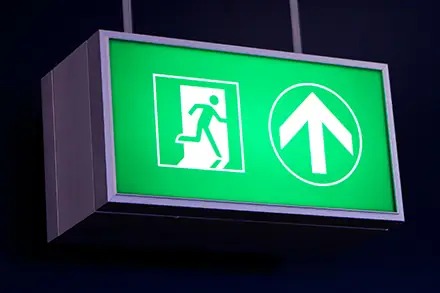
Emergency lighting provides crucial illumination during electricity outages or mains power failures. Without it, such events can lead to fires, power cuts, and dangers for building occupants. This type of lighting ensures that escape routes are well-lit and identifiable during emergencies. High occupancy areas, such as railway stations, hospitals, shopping centres, airports, stadiums, government buildings or leisure facilities, often use them.
Maintained or Non-Maintained Emergency Lighting
Emergency lighting comes in two main types, maintained and non-maintained.
Maintained Emergency Lighting
This type functions as a regular light fitting when mains power is available. In case of a power loss or emergency, it operates at full brightness. The advantage is that it serves as a normal fitting during non-emergency situations, eliminating the need for separate fittings.
A great example of a maintained emergency light is The KSR KSR97193/EM | Starlet 18W 3000K/4000K/6000K CCT IP44 LED Emergency Flat Panel Downlight.
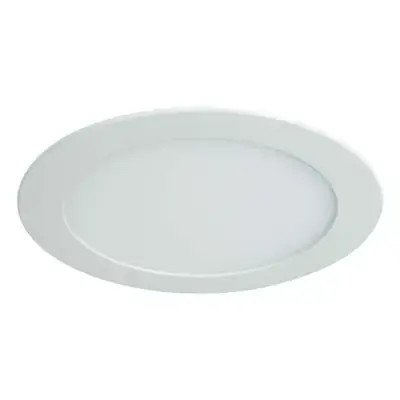
The KSR KSR97193/EM is an 18w IP44-rated LED emergency flat panel downlight, offering selectable colour temperatures of 3000K, 4000K, and 6000K. Ideal for both maintained and emergency lighting, it provides reliable illumination with energy efficiency, making it perfect for a variety of indoor applications.
Non-Maintained Emergency Lighting
This type remains in standby mode under normal conditions, consuming very little power and providing no illumination. If an emergency occurs, it activates using its backup power source, typically a battery.
An excellent example of an emergency light which can be non-maintained is the KSR KSR98125 | Navara 3.5w Emergency Exit Bulkhead Non Self Test.
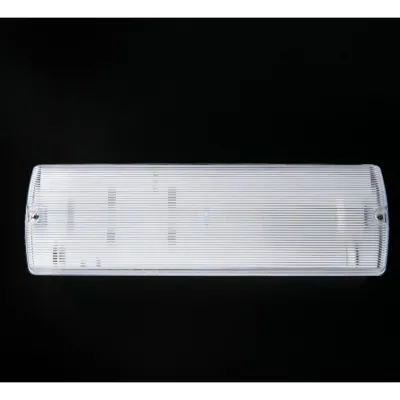
This 3.5w non-self-test emergency exit bulkhead is designed for reliable performance in emergency situations. With its durable construction and clear light production, it’s ideal for ensuring safe evacuation in various indoor environments.
The key difference is that maintained lighting functions both as regular lighting and emergency lighting, while non-maintained lighting solely provides illumination during emergencies, staying in standby mode otherwise. Your building may require specific types of emergency lighting for installation.
Positioning Your Emergency Lighting:
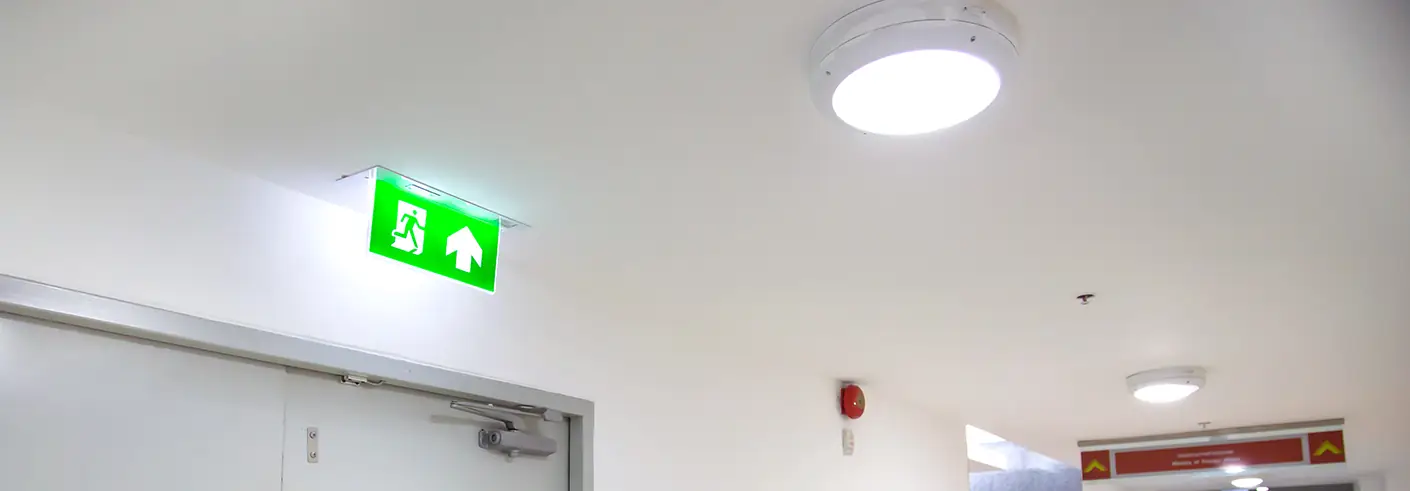
It not only illuminates fire exits, but also provides vital guidance along escape routes, such as along steps and stairways, directing occupants to fire and first aid points. It also highlights changes in direction.
Position your lights to clearly show exit routes leading to exits from the premises. If the exit route is not readily identifiable, use a sign instead of a lighting unit. Clearly highlight access to fire call points and firefighting equipment.
A brilliant example of an emergency exit sign light is the KSR KSR98104 | Navara Self Test Emergency 4 in 1 Light.
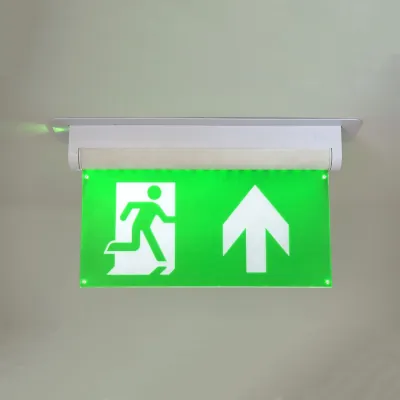
This versatile 4-in-1 self-test emergency light offers multiple configurations for exit signs and emergency illumination. Ita self-testing feature ensures reliability and simplifies maintenance, making it a perfect choice for enhancing safety im commercial and public buildings.
Please Note: This is only supplied with the Up arrow legend, others can be bought seperately.
Where is Emergency Escape Lighting Necessary?
- Steps, stairways and ramps.
- Lifts.
- Intersection of corridors.
- Changes in floor level.
- Fire and first aid points.
- All exit doors, including the final exit.
- Fire alarm call points.
- Fire-fighting equipment.
- Equipment that needs to shut down in an emergency.
- Escape routes.
- Escalators.
- Toilets.
- Generators.
- Large open areas.
- Windowless rooms and toilet accommodation exceeding 8m².
According to the HM Government publication on fire safety risk assessments, emergency lighting should cover areas in premises greater than 60m². Each noted place should have enough overall lighting for clear visibility.
Emergency Lighting Regulations in the UK:

Emergency lighting is cruical for a building’s fire safety provisions. The Industry Committee for Emergency Lighting (ICEL) states that “The legal requirement is that non-domestic buildings must be safe at all times, even if mains power failure occurs. Therefore, nearly all such buildings must have emergency lighting fitted”.
ICEL is the UK’s authority on emergency lighting, providing third-party accreditation for components and products under the guidance of the Lighting Industry Association (LIA).
The Regulatory Reform (Fire Safety) Order 2005 (FSO) governs fire safety in non-domestic properties in the UK. It requires building owners or employers to provide suitable emergency lighting based on a building’s risk assessment.
The British Standards Institution (BSI)’s umbrella standard for emergency lighting is BS 5266-1, which details the code of practice for the emergency lighting of premises. You can find more detailed requirements for emergency lighting regulations in the UK here.
In addition, the British and European standard, BS EN 1838, defines ’emergency lighting’ as equipment that provides illumination when the normal lighting supply fails. It also specifies the two main types “i) emergency escape lighting (ii) standby lighting”. Emergency escape lighting is defined as “that part of emergency lighting that is provided to enable safe exit in the event of failure of the normal supply”, while standby lighting is defined as “that part of the emergency lighting provided to enable normal activities to continue in the event of failure of the normal mains supply”.
Maintenance and Testing of Emergency Lighting:
According to government guidelines from ‘Fire safety risk assessment: offices and shops’, all emergency escape lighting systems should undergo regular testing and maintenance to appropriate standards, i.e., BS 5266 – Code of Practice for the emergency lighting of premises.
Traditionally, these tests are carried out manually, but many emergency lighting devices now come with self-test features. A typical test occurs via a key-operated switch, ‘secret key’, designed to prevent non-authorised personnel from operating the test switch. This switch is often near the main fuse board or adjacent to relevant light switches. Keeping a record of tests and findings in the fire safety logbook is advisable. Although this is not compulsory by law, it is useful for demonstrating compliance with fire safety legislation.
Testing would usually Include the Following:
- Daily visual checks on central controls if a centrally powered system with slave luminaires is installed.
- Monthly function tests by operating the test facility long enough to ensure that each emergency lamp illuminates.
- Annual full discharge tests to ensure that lamps remain lit for the full discharge period (usually 3 hours) and that the batteries recharge properly. Caution is required after a full discharge test, as batteries typically take 24 hours to recharge. Do not reoccupy the premises until the emergency lighting system is fully operational unless you make alternative arrangements.
In Conclusion:
As environments modernise, the need for emergency lighting grows, especially in highly populated, high-risk, and complex buildings. It plays a vital role in ensuring safe evacuations safely in power outages or emergency situations.
Adhering to the relevant UK regulations such as FSO and BS 5266-1 ensures that your building remains compliant and safe for all occupants.

